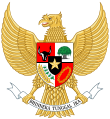Rukun warga
Appearance
| This article is part of a series on the |
| Politics of Indonesia |
|---|
 |
| Rukun Warga (RW) | |
|---|---|
| Category | RW |
| Location | Republic of Indonesia |
| Government |
|
Rukun Warga (RW) is the division of regions in Indonesia under the Village or Kelurahan (or under: Dusun or village). Rukun Warga not including the division of administration, and the formation of local communities is through consultation in the framework of community service set by the village or villages. RW is further divided into Rukun Tetangga (RT). Most information about governance and functioning of the RW and RT is in Indonesian.[1][2] Some non-Indonesian anthropologists have written about the functions and issues of the RW.[3][4][5][6]
See also
Notes
- ^ Jakarta Raya (Indonesia). Biro Administrasi Wilayah (2005), Buku petunjuk pelaksanaan rukun tetangga dan rukun warga (RT-RW), dewan kelurahan dan dewan kota/kabupaten Provinsi DKI Jakarta, Biro Administrasi Wilayah, Provinsi DKI Jakarta, retrieved 15 July 2016
- ^ Jakarta Raya (Indonesia). Direktorat I/Pemerintahan; Jakarta Raya (Indonesia). Kantor Urusan Penduduk (1971), Himpunan peraturan kependudukan : pedoman bagi para lurah, rukun tetangga (RT), rukun warga (RW) dan petugas2 lainnja, tentang kependudukan Daerah Chusus Ibukota Djakarta, s.n, retrieved 15 July 2016
- ^ Mearns, David (1999-04-01), "Urban Kampongs in Ambon: whose domain? Whose desa?(Indonesia)", The Australian Journal of Anthropology, 10 (1), Australian Anthropological Society: 15(1), ISSN 1035-8811
- ^ Guinness, Patrick (2015-12-08), Kampung, Islam and State in Urban Java, NUS Press - National University of Singapore, retrieved 15 July 2016
- ^ Guinness, Patrick; Asian Studies Association of Australia (1986), Harmony and hierarchy in a Javanese kampung, Oxford University Press, ISBN 978-0-19-582666-1
- ^ Guinness, Patrick (1981), Rukun Kampung : social relations in urban Yogyakarta, retrieved 15 July 2016
